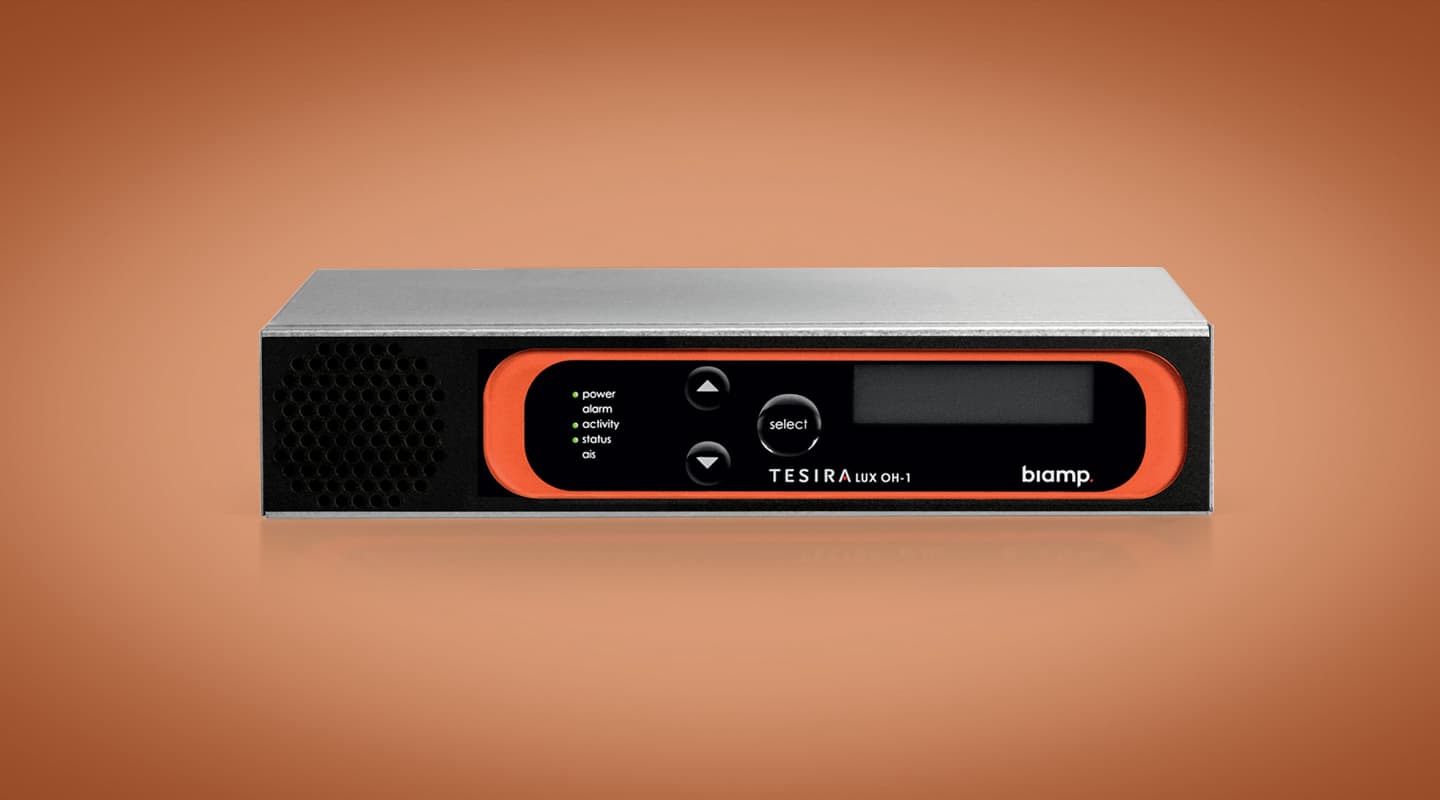
Preview: Biamp Tesiralux
Product Manager Chris Fitzsimmons talks AV AsiaPacific through Biamp’s big new product release:
Tesiralux adds video to the Tesira platform. In the initial announcement we’ve unveiled the Tesiralux ‘twins’: the encoder and decoder.
Some people have expressed some surprise: “What’s an audio company doing releasing an IP video product?”. We may have been doing a very good impression of an audio company for the last 10 years but for much of that time we’ve had 100 years-plus of combined video encoding experience beavering away in a back room.
Our team was supplemented back in 2014 when we employed a number of people from LabX, which was a third-party IP developer for people who wanted to use AVB.
I’m not the first product manager of Biamp video products, I’m just the first guy who’s allowed to tell anyone about it. Biamp is conservative and we waited until we were sure. None of our gear comes back, it doesn’t break and we can’t jeopardise that reputation.
ONE PLATFORM
The big idea is we’ve created a unified AV-over-IP distribution platform. It’s not a case of needing a separate DSP platform and a video-over-IP platform and getting them communicating via hand signals or analogue cabling or typing in IP addresses. This is a single environment upon which an AV integrator can build an AV-over-IP distribution network. They can have all our DSP and all the good stuff we’ve been working on in Tesira for the last 10 years, plus the highest quality video processing.
Like everything else we do, Tesiralux is on AVB and the products are fully part of the Tesira platform — no new software, no new environment, just new inputs and outputs.
The video encoder features DisplayPort and HDMI inputs, and the decoder has HDMI outputs. Both have standard mic/line Tesira inputs and outputs. You can use that mic/line I/O together or separately from the HDMI — they’re like one of our audio expanders gene-spliced into a video encoder. So you can take the two mic inputs and do what you want with them: combine them with the HDMI or route signal all around the Tesira platform as you wish.
VIDEO PROCESSING
Tesiralux can accept 4K 60Hz, 4:4:4 colour because we use the latest HDMI 2.0 spec inputs. We’re not allowed to call them ‘2.0’ but they are — HDMI believes we should pretend everything’s the same but it isn’t. You’ll see other vendors with 4K 30Hz or 4K 60Hz 4:2:0 because they have bandwidth restrictions on those older HDMI connectors. HDMI 2.0 allows for full 4K 60Hz 4:4:4 colour.
The v1.4 HDMI connector has bandwidth restrictions (10.2Gbps) but the 2.0 connector allows 18Gbps — essentially, the silicon on the connector is different. HDMI doesn’t want to talk about 2.0 because it doesn’t want snake oil merchants selling bogus ‘2.0 cable’.
Biamp: www.biamp.com
Australian Distributor: www.midwich.com.au
GUARANTEED SYNC
We can take eight channels of embedded audio over the HDMI or DisplayPort inputs, separate those channels out in the Tesira software, and route them off into an audio processing signal path and do some EQ or AEC, then re-integrate those into the stream. From there you could send them out of one the HDMI outputs of one of our decoders and know the audio will be lip synced — there’s no manual tweaking of delays to be done, it’s lip sync guaranteed. Alternatively you could take separate audio from the mic/line inputs and embed them into the video stream — all guaranteed to be time aligned. You can do this via the software — match outputs to be time aligned, put them in the same delay/EQ group and they’ll be lip synced. There’s no work that has to be done by the system integrator to get those inputs synced because Tesira is in charge of the whole piece.
Each one of these Tesiralux devices has a 4K scaler onboard. We have a FPGA programmable device doing the work. It’s not a fixed system on a chip, it’s a real brute of a video processing engine. EDID management is done at the end point. There’s no ‘EDID manager’, each decoder negotiates with the display to get the right resolution.
BANDWIDTH
If you look at 4K 60 4/2/2 10-bit video, which is a baseline that video production uses today, that represents about 9.95Gbps of data. If your customer has 10G infrastructure then happy days, you can have uncompressed 4K video. AVB will use 75% of the available bandwidth — so we’ll be doing a little bit of compression down to 7.5Gbps.
But that’s just one scenario: Biamp has very granular bandwidth control in the software. So you can choose to scale from 4K down to 1080p (if you don’t have 4K displays then there’s no point sending 4K video). Doing that, you’ve already quartered the output and there’s no need to compress. We can also alter the frame rate. So if you’re sharing spreadsheets you don’t need 60fps — unless you’ve had too much to drink the night before, that footage is not moving! You can drop the frame rate down to 15fps in software, and quarter your bandwidth and, again, there’s no need to compress. However, if you do want to compress, we have an MJPEG compression engine and that goes down to 20:1.
“”
It’s not just another encode/decode product. We have our integrated audio DSP that everyone trusts. We have this AVB piece that no one else has.
WHY MOTION JPEG?
We chose MJPEG compression over the alternatives because it suits Tesira’s applications best. And when it comes to light compression, we think MJPEG has the right combination of latency, perceived image quality and efficiency. It’s a DCT (discrete cosine transform) compression, not a wavelet compression, and that means the kinds of artefacts you see are slightly different. For commercial and education content, spreadsheets and PowerPoint mostly, we believe the DCT artefacts are more gentle. With wavelet compression, you tend to get some softening of edges, which is no good in Powerpoint.
SHARING BANDWIDTH
AVB is really where it’s at for video-over-IP networks. AVB has guaranteed bandwidth reservation which protects other content on a converged network. It means we can share bandwidth on a network with telephony or other data, without crushing whatever else is going on. If you look at some other video-over-IP products they basically want the whole damn plug. They’re going to take all of your 10G connection and there’s no way to dictate how much of that switch it uses, it’s just greedy.
AVB is a suite of standards that does a number of things. It guarantees QoS; it guarantees delivery with no more than 2ms of latency over seven hops. It does that by making a pipe for media traffic — separating it from other traffic on the switch and doesn’t let media traffic outside the pipe and other traffic inside. So by default it takes up three quarters of a channel of a network port. Our Tesira bandwidth controller allows us to choose how you fill that pipeline — frame rate, compression, resolution, the parameters that affect the size. Dialling up the bandwidth controller affects the reservation you want to make. It also means that if the IT department tells you that you’ve only got 5G of the 10G network you can dial down to 5G and stick to what the customer wants or can accommodate.
AVB is the real secret sauce when it comes to running a truly converged network.
AVB SWITCHES
AVB switches are somewhat expensive at the moment. The Cisco Nexus 7000 series — Cisco’s big data series — is AVB capable. The Cisco Catalyst 3850 is a mid-sized 48-port switch and AVB capable. But Cisco has other smaller switches that we can’t talk about yet that will soon have AVB capability. They’ll be in the sub-US$2000 range. There are other vendors, but Cisco is a lynchpin as there are lots of ‘Cisco Houses’ that won’t make the jump to Netgear or some other vendor.
TIME IS RIGHT
There’s a mountain of IP video products at InfoComm 2016. Not long ago our concern was perhaps we’re a bit early to market with Tesiralux but that’s not the case. One thing’s for sure, we don’t need to make the HDBaseT pros/cons argument anymore.
Our IP video solution has significant points of difference. It’s not just another encode/decode product. We have our integrated audio DSP that everyone trusts. We have this AVB piece that no one else has. And we put all that in the Tesira wrapper, so you don’t need to manage or learn two different platforms or somehow get them to talk to each other.
PUTTING THE ‘V’ IN AVB
We made a deliberate choice to go with AVB 10 years ago. We knew this day was coming — we knew Tesira would one day include video — so we knew we needed a networking platform that was going to cope with audio and video.
Biamp has talked about the benefits of AVB for a long time but the benefits of the bandwidth reservation only comes into play when you’re in the multi-gig world. Previously it was about reserving audio bandwidth but that’s only a couple of hundred Mbps. But as soon as you’re talking about a 6Gbps+ video payloads then you need AVB, because the alternative is to manually set up each switch. No one wants to do that. That’s just a headache.
Which is why most IP video vendors are using all the bandwidth, they’re not expecting anyone to make a converged network with their product.
BIAMP FUTURE
We sell tens of thousands of channels of AEC every year: people love it, it’s reliable. With Tesiralux we’re saying: you can do the whole system now. We can do video and audio. We’re not doing video walls and presentation switchers but if you want to move audio and video around a building and manage a network in a converged fashion then Biamp is the way to go. you can trust us because we have a reliable product.















RESPONSES